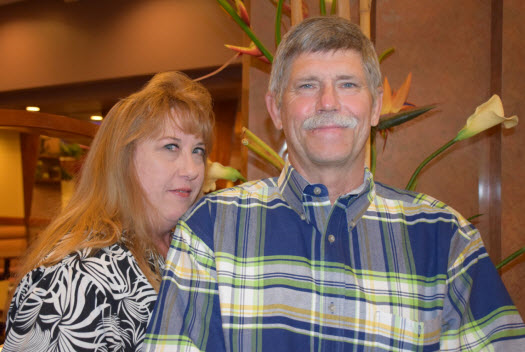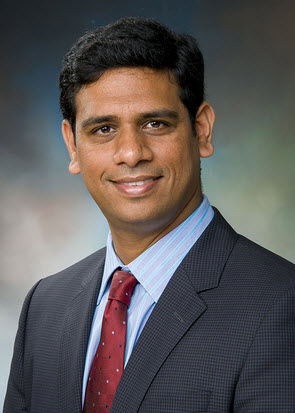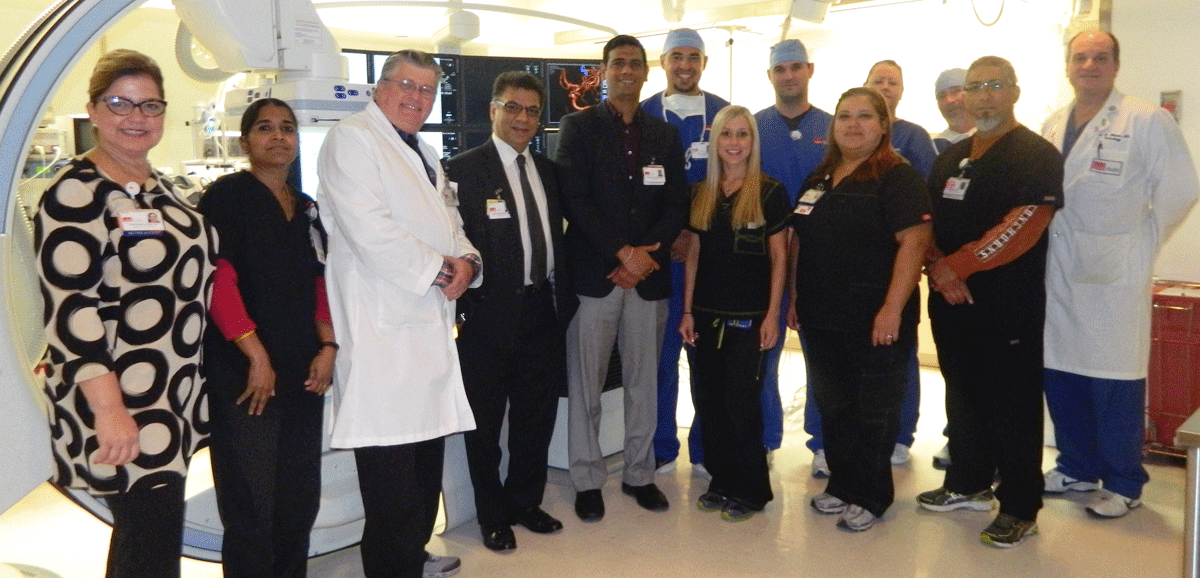
Ted Guth knows he has months of recovery ahead of him after suffering a stroke in January. But the 58-year-old Santa Fe resident also knows that his life could have gone down a much different path if it weren’t for the quick actions of his wife and a minimally invasive procedure now offered at UTMB.
One minute, Guth remembers sitting on his couch at home putting his shoes on. The next, he was waking up in the ICU at John Sealy Hospital, wondering what had happened.
His wife Kelly noticed his symptoms that Saturday morning.
“He was leaning over, struggling with his shoes and just looked kind of strange,” said Kelly. “He couldn’t maintain his balance and seemed to have no muscle control. Before I had time to react, he had slumped over and slid off the couch onto the floor.”
Fearing a heart attack or stroke, she immediately called 911 and Guth was taken to the Emergency Department at John Sealy Hospital. When he arrived, he was unable to speak and was paralyzed on his right side. A CT scan of Guth’s head and neck confirmed that he had suffered a stroke -- a blood clot was interrupting blood flow to an area of his brain.
Dr. Venkata Dandamudi, UTMB's director of neurointerventional services, assistant professor of neurology, neurosurgery and radiology, and his team at UTMB didn’t waste any time.
“With stroke, the sooner we can start treatment, the better,” said Dandamudi. “Once a stroke begins, neurons in the brain begin  to rapidly die, so every minute counts.”
to rapidly die, so every minute counts.”
Within 30 minutes of arriving at the ED, Guth received IV tPA, an intravenous drug that dissolves clots. He showed mild improvement, but there was still blockage. Dandamudi explained the situation to Kelly and got the OK to begin a minimally invasive procedure, called intra-arterial treatment. This therapy removes blood clots by advancing a catheter through an artery in the groin, up to the site of the clot. Dandamudi has performed more than 50 intra-arterial procedures since July of last year, and the results have been dramatic.
“We now have the technology that allows us to help more patients more than ever. Recent studies have demonstrated that intra-arterial treatment is about twice as likely to restore mobility and functional independence compared to clot-breaking drugs, and we are seeing that in our patients here at UTMB,” said Dandamudi. “Three years ago, this procedure wasn’t available and many stroke patients would end up in nursing homes. Today, more people are able to walk out of the hospital, get back to work and live independent lives.”
The minimally invasive procedure is available in only about half of the advanced stroke centers in the U.S., and UTMB is the only stroke facility south of Houston that offers the procedure.
In Guth’s case, the procedure worked wonders, although he still has a difficult time writing with his right hand and gets frustrated that he has trouble holding a conversation without forgetting words. However, Dandamudi says Guth has excellent rehab potential.
“Ted arrived at the hospital with paralysis on one side and completely aphasic – he couldn’t say a word or understand,” said Dandamudi. “After the treatment, he was walking while he was still in the hospital along with remarkable improvement in his speech. He has a touch of word-finding difficulty, with tremendous rehab potential. What’s amazing here is his wife Kelly’s efforts to recognize that he was having a stroke, the paramedics bringing him here without wasting any time, and being able to immediately start treatment. Everything went by the book, from A to Z.”
Kelly and her husband have nothing but compliments for the care staff at UTMB.
“Everybody who worked with us was totally awesome. From Dr. Busby [director of UTMB Stroke Services], to the therapists and nursing staff, it was a very good experience,” said Kelly. “We continue to be impressed with Dr. Dandamudi. Just the other day, I left Ted in the car while I ran into the UTMB Specialty Care Center to pick something up. I ran into Dr. Dandamudi inside and he asked how Ted was doing. I said he was out in the car and Dr. Dandamudi left the building and walked out into the parking lot and had a nice conversation with him. You just don’t get that kind of involvement with many doctors and it was great to see.”
Dandamudi said it’s truly a team effort.

“At UTMB, we are making strides in developing a multidisciplinary neurosciences collaborative effort enabling us to deliver state-of-the-art care to our patients,” said Dandamudi. “I commend the cohesive efforts of our emergency room care providers, interventional radiology staff, stroke service and neurointensive care providers, for delivering superb care to our community.”
Guth hopes to return to his job as an operator at a mechanical plant sometime in the future, but in the meantime, he’s keeping himself busy seeing a speech therapist every week and working around the house. Kelly smiles when she says he can’t sit still – in the last month, he’s put in a new dishwasher, kitchen faucet and has been busy planting trees and flowers.
The couple still doesn’t know what caused his stroke, but they do know that he’s lucky.
“We have a lot to be thankful for,” said Kelly. “We’re in a place we’ve never been before, but we see a lot of folks in rehab who will have a much longer road to recovery, and Ted is in a much better place. All we can do is say that the procedures they did at UTMB, the protocols they used, the timing of it all and their attention to him has got him where he is today – and you can’t ask for more than that.”
May is National Stroke Awareness Month
There is a saying: “Time is brain.” Once a stroke begins, neurons in the brain begin to rapidly deteriorate, and victims lose 10 percent of salvageable brain for every 15 minutes that they go untreated. Therefore, limiting the extent of damage requires urgent, expert evaluation and treatment. Fortunately for patients in the Houston-Galveston region, those precious moments awaiting treatment do not have to be wasted.
UTMB is a Joint Commission Certified Primary Stroke Program, a designation that recognizes organizations for exceptional outcomes in stroke care.
The Stroke, Neurovascular and Neurointerventional Program at UTMB provides a comprehensive, interdisciplinary approach to caring for stroke patients and patients with a wide range of complicated disorders of the blood vessels of the brain and spine, such as brain aneurysms, arteriovenous malformations, arteriovenous fistula, carotid/vertebral artery stenosis and other neurovascular conditions.
Because treatment can be more effective if received quickly, every minute counts when stroke strikes. For more information on how to spot a stroke or to see stroke services available at UTMB, click here.